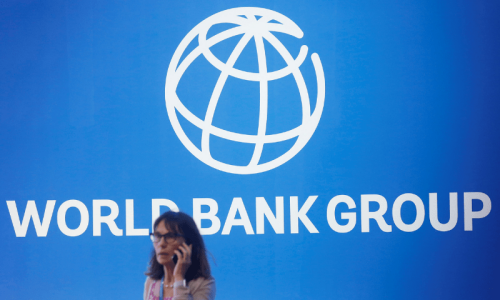ISLAMABAD: The Asian Development Bank (ADB) on Wednesday forecast Pakistan’s GDP would grow by two per cent during the current year subject to successful vaccine rollout and implementation of stabilisation measures.
“Assuming successful vaccine rollout and the implementation of economic reform under a stabilisation programme with the International Monetary Fund (IMF), GDP is expected to grow by 4pc in FY2022 as consumption strengthens and investor confidence improves,” the ADB said in its flagship Asian Development Outlook (ADO) 2021.
However, the economic outlook is subject to downside risks, depending on persistent containment measures and success in achieving the vaccination target of 70pc of the eligible population by the end of December 2021.
The ADB’s forecast is closer to 1.3pc growth forecast by the World Bank and 1.5pc by the IMF when compared to 2.9pc and 3pc growth estimates by the Ministry of Finance and State Bank of Pakistan, respectively.
It said inflation would be down to 8.7pc this year against 10.7pc last fiscal year. It said the real GDP reversed growth at 1.9pc in FY2019 to contract by 0.4pc in FY2020 as economic activity was depressed by Covid-19 containment measures and earlier economic stabilisation efforts initiated before the pandemic. “The downturn was worsened by currency depreciation and fiscal tightening.”
The Manila-based lending agency forecast that the South Asian region would post a 9.5pc growth this year, led by 11pc in India and 13pc in Maldives. Bangladesh’s economy would grow by 6.8pc, while Afghanistan and Nepal would see about 3pc GDP growth rate and Sri Lanka 4.1pc. Bhutan economy would be contract by 3.4pc. Economic power house China is forecast to grow by 8.1pc this year.
The ADB said Pakistan’s agriculture was forecast to see slower growth, mainly because of a sharply lower cotton harvest following heavy rains, pest attacks and continued contraction in cultivated area. Other major crops, notably rice, sugarcane and maize, look set to exceed output in FY2021 after the government subsidised agricultural inputs and bank credit.
Industry and services already show signs of recovery in FY2021 with fiscal incentives granted to key construction and export industries and subsidised credit offered to protect employment and stimulate growth. Industry appears poised for robust growth led by manufacturing and construction.
Large-scale manufacturing, which accounts for over half of the industry sector, reversed contraction by 3.2pc in the first seven months of FY2020 to expand by 7.9pc during the same period of FY2021. Support in FY2021 came from strong growth in businesses allied with construction and from the food-processing industry, amply supplied with substantial imports of un-milled wheat and by higher sugarcane output. Services are expected to rebound as retail and trade pick up, and as schools and nonessential services reopen.
Despite low interest rates and, early in the fiscal year, further electricity tariff adjustments and food supply interruptions, headline inflation is projected to slow to 8.7pc in FY2021. This partly reflects government subsidies for wheat and sugar imports, its careful monitoring of prices for essential commodities and improved food supply later in the fiscal year.
The central bank has kept its policy rate at 7pc to support economic recovery. This accommodative stance is made possible by lower inflation expectations and a stable exchange rate. Growth in private sector credit picked up in the first half of FY2021, led mainly by construction, wholesale and retail trade and consumer spending. Growth reflected lower borrowing costs, subsidised credit schemes and tax concessions for construction.
With fiscal consolidation expected to resume and the government likely to continue its policy of not borrowing from the central bank, inflation is projected to slide to 7.5pc in FY2022. Assuming that stabilisation efforts are sustained and economic recovery is timely, public debt is expected to fall as a percentage of GDP.
The current account deficit is expected to narrow slightly to the equivalent of 1pc of GDP in FY2021 with support from robust remittances. The current account deficit is projected to widen again in FY2022 to equal 2pc of GDP on robust growth in imports as recovery strengthens and a surge in remittances tapers.
The pandemic has highlighted that Pakistan needs to address the challenges of its private sector, in particular the prevalence of SMEs (small and medium enterprises) that operate informally. An estimated 3.3 million SMEs in Pakistan engage some 40 million households in entrepreneurial activity. SMEs operate across the economy, including agriculture and livestock, trade and manufacturing, and services. SMEs provide at least 30pc of GDP, employ 80pc of non-farm labour and produce a significant percentage of exports.
However, their contribution to GDP is smaller than in other low-income countries, where it reaches up to 60pc. The low economic share of SMEs reflects their low value addition in a challenging macroeconomic environment with scarce credit, high inflation, an unstable currency and inadequate infrastructure. These constraints hamper SME efforts to take full advantage of Pakistan’s open economy and increasingly accessible world markets.
In general, SMEs lack a supportive public sector, skilled labour, trade capacity, and access to finance. Only 21pc of adults and 7pc of women have bank accounts, well below Pakistan’s regional peers. In Bangladesh, for example, 50pc of adults and 36pc of women have bank accounts. Credit is a crucial challenge as commercial banks do not prioritise lending to SMEs, preferring to lend instead to the public sector or to large, low-risk enterprises.
Published in Dawn, April 29th, 2021













































